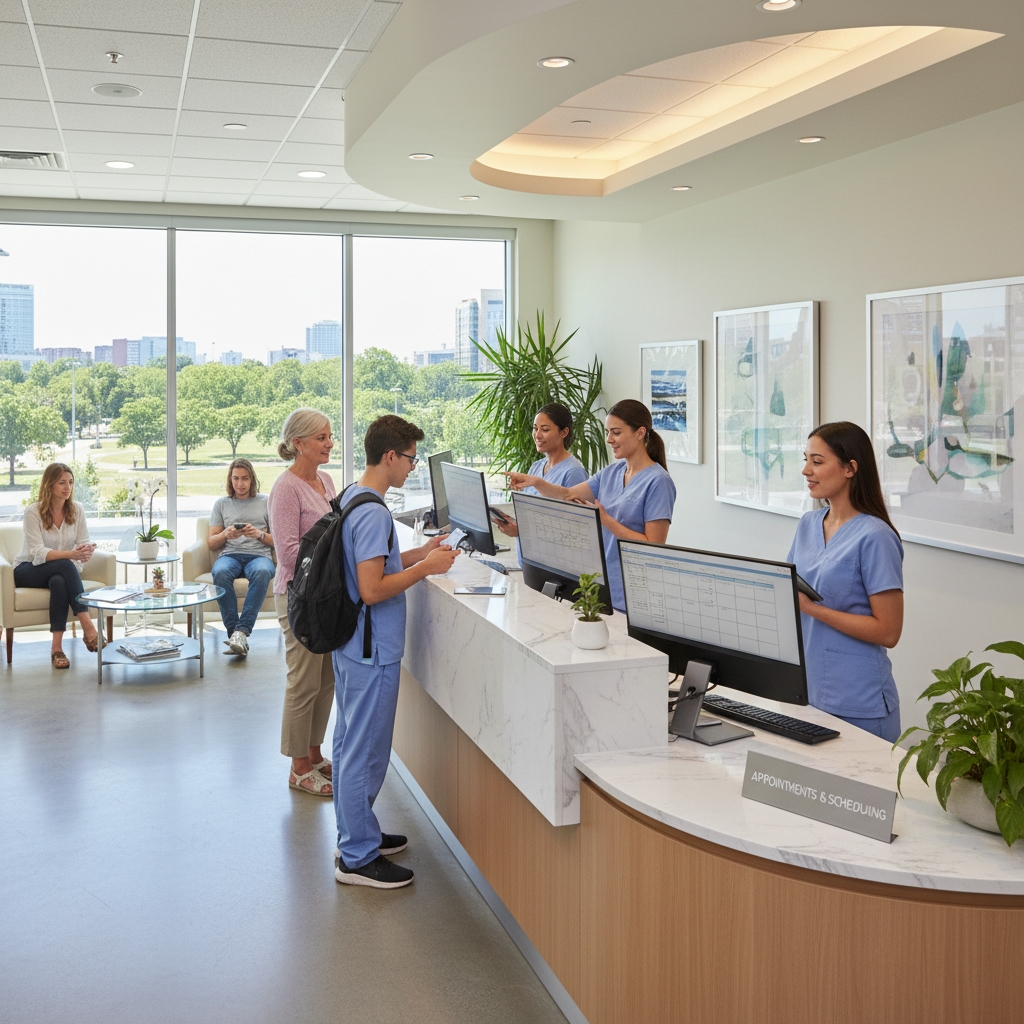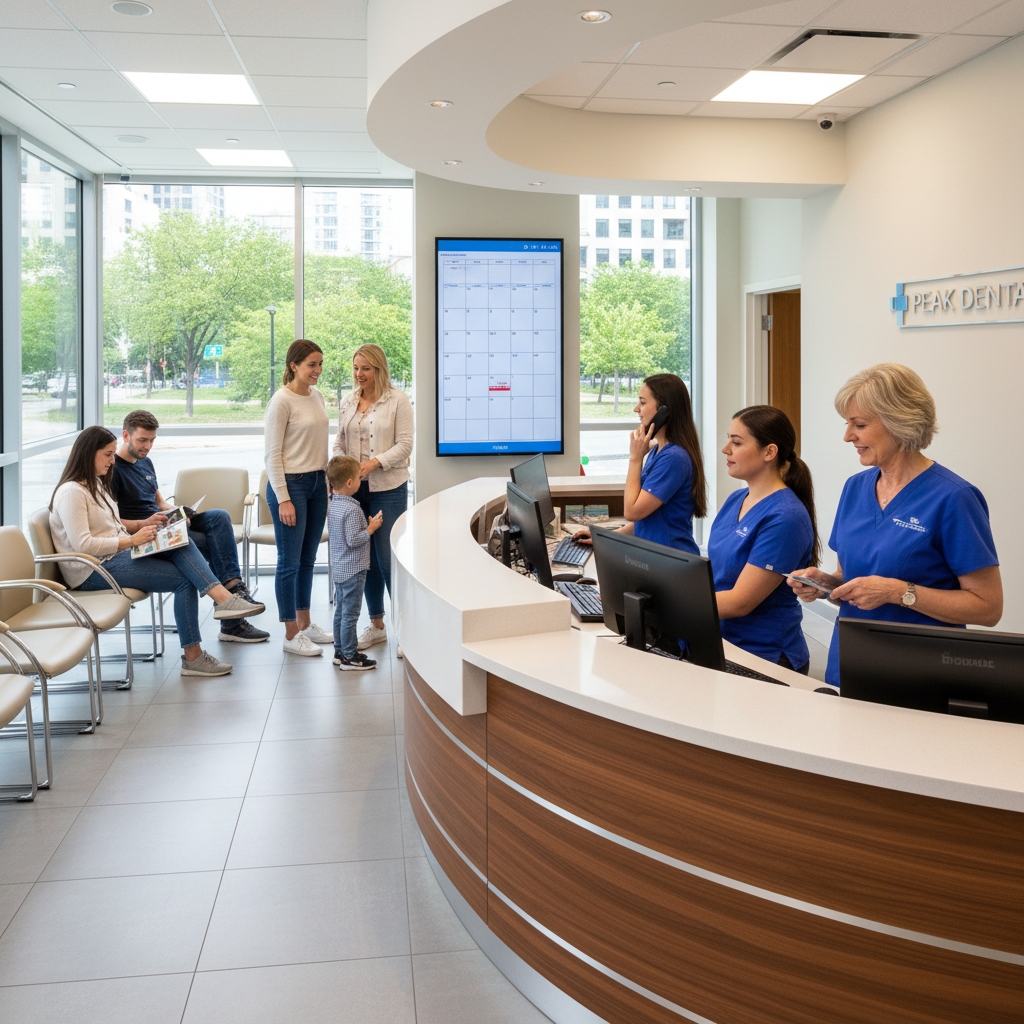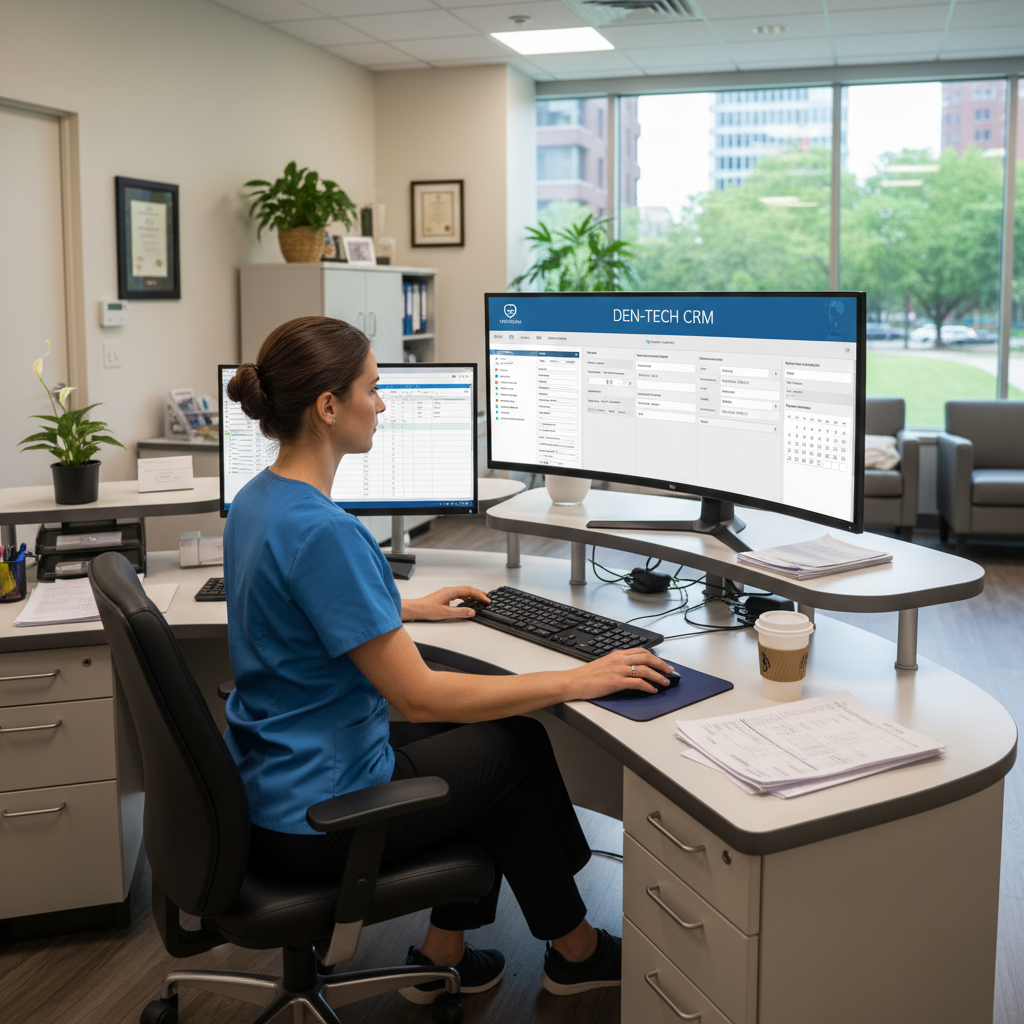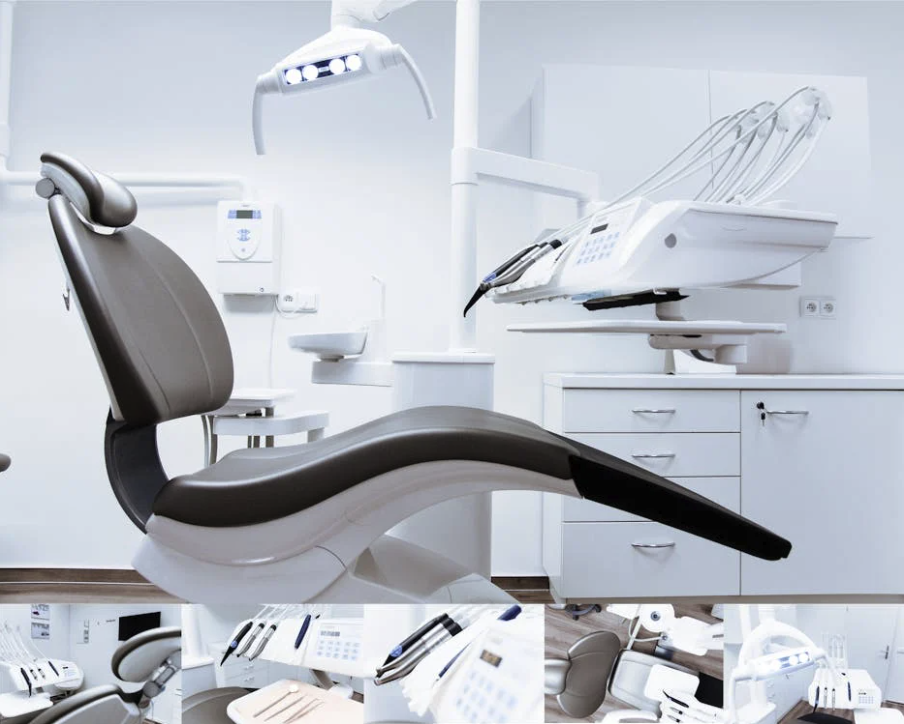












Blog Article


How to Capture Missed Calls and Turn Them into Scheduled Appointments - Guide For Dentists and Dental Support Organizations (DSOs)
Missed calls represent lost revenue for dental practices, with each unanswered call potentially worth hundreds or thousands of dollars in treatment value. Modern AI-powered systems can automatically capture these missed calls and convert them into scheduled appointments, helping dental practices and DSOs recover up to 60% of previously lost opportunities. Studies show that dental practices reduce missed appointments when AI quickly engages patients after unanswered calls, offering convenient scheduling options around the clock.
The challenge extends beyond individual practices to large DSOs managing multiple locations with varying call volumes and staffing levels. Traditional solutions like answering services often fail to capture patient information effectively or provide the personalized experience patients expect when calling about dental care.
Voice AI technology now allows practices to automatically handle missed calls with intelligent agents that can book appointments, answer common questions about treatments and insurance, and follow up via text messages. This automated approach ensures no potential patient slips through the cracks, regardless of when they call or which location they contact.
Key Takeaways
- AI systems can automatically capture missed calls and convert up to 60% into scheduled appointments for dental practices
- DSOs benefit from centralized missed call management across multiple locations with consistent patient engagement
- Automated follow-up through voice AI and text messaging prevents revenue loss from unanswered patient calls
Missed Calls in Dental Clinics
Dental practices lose significant revenue when calls go unanswered, with studies showing only 68% of new patient calls are answered and just 42% of answered calls convert to appointments. Peak hours and after-hours periods create the biggest challenges for maintaining consistent phone coverage.
Average Missed Call Rates for Dentists and DSOs
Most dental practices miss 32% of incoming calls from new patients. This means dental clinics can reduce missed calls through better staffing strategies during busy periods.
Of the calls that do get answered, only 42% result in scheduled appointments. This creates a compound problem where practices lose 71 potential new patients for every 100 calls received.
Single-location practices typically have higher miss rates than DSOs due to limited staffing resources. DSOs with centralized call centers often achieve better answer rates but may struggle with personalized patient experiences.
Small practices with 2-3 front desk staff members face the greatest challenges. They cannot maintain phone coverage during lunch breaks, emergencies, or when staff members are assisting patients in the office.
Impact on Clinic Revenue and Patient Satisfaction
Each missed call represents lost revenue that compounds over time. A practice that receives 100 new patient calls monthly could lose over $200,000 annually in potential appointments.
Revenue Loss Breakdown:
- 32 unanswered calls per 100 received
- 39 answered calls that don't convert to appointments
- 71 total lost opportunities per 100 calls
Patient satisfaction drops when calls go unanswered because dental issues often require prompt attention. Patients experiencing pain or dental emergencies will quickly call competing practices if their initial call isn't answered.
Missed calls in dental practices stop losing money when proper systems are implemented to capture every opportunity. New patients who cannot reach a practice immediately are 73% more likely to book with a competitor within the same day.
Peak-Hours and After-Hours Call Challenges
Monday mornings and lunch hours create the highest volume of missed calls in dental practices. Patients typically call to schedule appointments at the beginning of the work week or during their own lunch breaks.
High-Risk Time Periods:
- 8:00-10:00 AM on Mondays
- 12:00-1:00 PM daily
- 4:00-6:00 PM weekdays
- Weekend emergency calls
After-hours calls present unique challenges because many involve urgent dental issues. Practices without proper after-hours coverage lose emergency patients who generate higher revenue per visit.
Staff scheduling conflicts during peak periods lead to inadequate phone coverage. Front desk employees cannot answer phones while checking patients in, processing payments, or handling insurance verification tasks simultaneously.
DSOs often struggle to maintain consistent phone standards across multiple locations during peak times. Each location may have different staffing levels and call volume patterns that require customized coverage solutions.
Lost Appointments and Revenue Leakage
Dental practices lose significant revenue when calls go unanswered, with studies showing that 68% of calls remain unanswered and only 42% of answered calls result in appointments. This creates a compounding effect where missed opportunities directly impact both immediate revenue and long-term patient acquisition costs.
Revenue Impact from Unanswered Calls
Every missed call represents a direct revenue loss for dental practices. When potential patients cannot reach the office, they typically move on to competitors within the same day.
The financial impact extends beyond immediate appointment losses. Practices invest heavily in marketing to generate these calls, making each unanswered phone ring a waste of advertising dollars.
Key Revenue Losses Include:
- Lost new patient examinations ($200-$400 each)
- Missed treatment consultations ($500-$2,000+ potential)
- Emergency appointments ($300-$800 immediate revenue)
- Follow-up treatments and cleanings
Patient acquisition costs average $200-$300 per new patient through digital marketing. When calls go unanswered, practices lose both the marketing investment and potential lifetime patient value.
The ripple effect damages customer satisfaction scores. Patients expect immediate responses, and missed calls impact medical revenue by creating negative first impressions that spread through online reviews.
Estimating Value of Missed Appointments
Calculating missed appointment value requires analyzing call volume, conversion rates, and average treatment values. Most dental practices can estimate their losses using simple metrics.
A practice receiving 100 new patient calls monthly loses approximately 71 potential patients based on industry averages. Each lost patient represents $1,200-$1,800 in first-year revenue potential.
Monthly Loss Calculation:
- 100 incoming calls
- 32 unanswered calls (32% miss rate)
- 28 answered calls with poor conversion (40% of 68)
- Total missed opportunities: 60 patients
- Monthly revenue loss: $72,000-$108,000
Emergency calls carry higher immediate value. A single missed emergency appointment can cost $500-$1,200 in same-day revenue, plus the patient often seeks care elsewhere permanently.
Customer experience deteriorates when patients cannot schedule appointments easily. This affects long-term retention rates and referral generation, multiplying the financial impact over time.
Real-World Dental Metrics and Case Studies
Industry data reveals consistent patterns across dental practices of all sizes. Smaller practices often experience higher miss rates due to limited front desk staffing during peak hours.
One documented case study showed a practice improving conversion rates from 35% to 65% after implementing proper call handling systems. This generated 244 additional appointments valued at $204,687 within months.
Performance Benchmarks:
- Average answer rate: 68%
- Conversion rate (answered calls): 42%
- Peak miss times: 11 AM-2 PM, 4 PM-6 PM
- Emergency call value: $500-$800
DSOs report similar patterns across multiple locations. Practices with dedicated call management systems achieve 15-25% higher new patient acquisition rates compared to those relying solely on front desk staff.
The customer satisfaction impact extends beyond immediate appointments. Patients who experience difficulty scheduling initial appointments show 40% lower retention rates for preventive care visits, reducing lifetime value significantly.
Barriers to Call Answering and Booking
Dental practices face significant challenges when managing incoming calls, with 27% of calls in home services going unanswered, leading to substantial revenue loss. Understaffed front desks, outdated manual processes, and patient frustration create barriers that prevent successful appointment scheduling.
Front Desk Staffing and Overload Problems
Dental practices often operate with minimal front desk staff who juggle multiple responsibilities simultaneously. When the front desk team handles check-ins, insurance verification, scheduling, and payment processing, incoming calls frequently go to voicemail.
Peak calling times create additional strain. Most patients call during lunch breaks or after work hours when dental offices experience their highest volume of inquiries. A single receptionist cannot effectively manage walk-in patients while answering multiple phone lines.
Common staffing challenges include:
- Limited staff coverage during busy periods
- Multitasking demands that reduce call availability
- No dedicated call handler for appointment bookings
- Inadequate coverage during breaks and lunch periods
Staff turnover compounds these problems. Training new front desk employees takes weeks, during which call handling efficiency drops significantly. Companies can lose up to 30% of potential customers when calls go unanswered, making staffing consistency crucial for dental practices.
Manual Follow-Up Versus Automated Solutions
Traditional manual follow-up methods create bottlenecks that prevent effective missed call recovery. Staff members must manually return each missed call, check voicemails, and attempt to reach patients multiple times before connecting.
Manual processes consume valuable time. Front desk staff spend hours each day returning missed calls instead of focusing on in-office patient needs. Many practices lose potential patients because staff cannot follow up quickly enough.
Automation offers several advantages:
- Instant response to missed calls via text messages
- Automated appointment booking links sent immediately
- Voicemail transcription for faster response prioritization
- Scheduled follow-ups without manual intervention
Automated systems can capture patient information and send booking confirmations without human involvement. Smart automation systems help dental practices recover 60% of missed call leads through instant text follow-ups and online scheduling capabilities.
Reducing Dental Patient Frustration
Patient expectations have changed dramatically in recent years. Patients expect immediate responses and convenient scheduling options similar to other service industries they interact with daily.
Long hold times create negative first impressions. When patients call to schedule urgent dental appointments or address pain concerns, waiting on hold increases their stress levels. Many patients hang up and call competing practices instead.
Key frustration points include:
- Busy signals during peak calling hours
- Lengthy hold times without call-back options
- Voicemail-only responses for urgent dental needs
- Delayed return calls that extend scheduling timelines
Streamlined call handling reduces patient abandonment rates significantly. Practices that implement efficient call management systems retain more patients and generate higher satisfaction scores. Quick response times demonstrate professionalism and care that patients associate with quality dental services.
Automated Solutions for Missed Calls
Modern dental practices lose up to 85% of potential patients who don't receive immediate responses to their calls. Automated AI systems handle missed calls 24/7 while specialized platforms integrate directly with dental practice management software to convert inquiries into confirmed appointments.
Patient-Engagement Platforms for Dentists
Dental-specific patient engagement platforms connect directly to practice management systems like Dentrix and Eaglesoft. These platforms automatically detect missed calls and trigger immediate responses through multiple channels.
Key Platform Features:
- Direct integration with dental software
- HIPAA-compliant communication channels
- Automated insurance verification requests
- Treatment-specific appointment routing
The technology captures caller information and presents scheduling options based on appointment type. Emergency calls receive priority routing to on-call staff. Routine cleanings, consultations, and follow-ups get directed to appropriate scheduling workflows.
Most platforms offer customizable response templates for different procedure types. Orthodontic consultations receive different messaging than emergency tooth pain calls.
Features That Improve Appointment Scheduling
Automated scheduling features reduce no-shows and improve patient conversion rates. Marketing automation software creates workflows that nurture leads from missed calls through confirmed appointments.
Essential Scheduling Features:
FeatureBenefitImplementationReal-time availabilityShows open slots instantlySyncs with practice calendarInsurance verificationConfirms coverage before bookingIntegrates with clearinghousesTreatment-specific bookingRoutes by procedure typeCustom workflows per serviceConfirmation sequencesReduces no-showsAutomated reminders via SMS/email
Advanced systems offer online scheduling links sent via text message. Patients book appointments without phone calls. Payment collection features secure deposits for expensive procedures like implants or cosmetic work.
Two-way SMS communication allows patients to reschedule or cancel appointments. This reduces administrative workload for front desk staff.
Measuring Automated System Effectiveness
Dental practices track specific metrics to evaluate automated call handling performance. Call conversion rates measure how many missed calls become scheduled appointments.
Key Performance Indicators:
- Response time: Under 60 seconds for optimal conversion
- Conversion rate: 25-40% typical for dental practices
- No-show reduction: 15-30% improvement with automation
- Staff time savings: 2-4 hours daily for busy practices
Monthly reports show missed call patterns by day and time. Peak missed call periods often occur during lunch hours and after business hours. Weekend emergency calls represent high-value conversion opportunities.
ROI calculations compare automation costs against recovered revenue from converted calls. Most dental practices see positive returns within 60-90 days. Emergency appointments and complex procedures generate the highest value per converted call.
Practice management integration provides detailed analytics on appointment types generated through automated systems. This data helps optimize messaging and scheduling workflows for maximum effectiveness.
DSO Needs and Multi-Location Challenges
Dental Service Organizations face unique obstacles when managing missed calls across multiple practice locations. These challenges include inconsistent communication protocols, fragmented data reporting, and the need for centralized solutions that maintain brand consistency.
Coordinating Across Multiple Locations
DSOs struggle with inconsistent workflows across different systems that create operational inefficiencies. Each location may handle missed calls differently, leading to varying patient experiences and lost appointment opportunities.
Common coordination problems include:
- Different staff training levels for call handling
- Inconsistent follow-up procedures between locations
- Varied response times to missed calls
- Separate phone systems without centralized oversight
A unified communication platform eliminates these disparities. It ensures every location follows the same missed call protocols and maintains consistent patient touchpoints.
Staff at all locations receive identical training materials and procedures. This standardization reduces confusion and improves conversion rates from missed calls to scheduled appointments.
Centralized management allows DSO administrators to monitor call performance across all sites. They can identify which locations excel at converting missed calls and replicate those practices organization-wide.
Analytics and Revenue Attribution for DSOs
Multi-location DSOs need comprehensive reporting that breaks down missed call data by individual practice sites. This granular view helps identify underperforming locations and optimize resource allocation.
Key metrics DSOs track include:
- Missed call volume per location
- Conversion rates from callbacks to appointments
- Revenue attributed to recovered missed calls
- Average response time by practice site
- Patient satisfaction scores for call handling
Revenue attribution becomes complex when patients call multiple locations or transfer between practices. Advanced tracking systems link missed calls to eventual appointments, even across different DSO locations.
Real-time dashboards provide DSO executives with immediate visibility into call performance. They can spot trends like seasonal fluctuations or location-specific challenges that require intervention.
Data consolidation eliminates the silos that plague multi-location operations. Instead of manually collecting reports from each practice, DSO managers access unified analytics that compare performance metrics across their entire network.
Custom Integration and White-Label Solutions
DSOs require seamless integration with existing practice management software across all locations. Custom API connections ensure missed call data flows directly into patient records and scheduling systems without manual data entry.
White-label solutions maintain brand consistency across the DSO network. Patients receive callbacks and communications that reflect the local practice brand rather than third-party vendor messaging.
Integration capabilities include:
- Patient management system synchronization
- Automated appointment scheduling
- Insurance verification workflows
- Treatment plan follow-up sequences
Custom reporting structures accommodate DSO-specific needs like regional performance comparisons and corporate-level analytics. These tailored solutions provide insights that generic software cannot deliver.
Multi-location licensing models offer cost efficiencies for DSO implementations. Volume pricing and centralized billing simplify vendor management while reducing per-location expenses for scaling DSO operations.
Technical support teams understand DSO complexities and provide dedicated assistance for multi-site deployments. This specialized support ensures consistent implementation across all practice locations.
Boosting Conversion With Empathetic AI
Modern AI voice assistants can reduce missed calls by up to 95% while maintaining human-like interactions. These systems use natural conversation patterns and follow-up automation to convert dental inquiries into confirmed appointments.
Context-Aware Chats and AI Booking
AI systems for dental practices recognize specific patient needs based on conversation context. When a patient mentions tooth pain, the AI prioritizes emergency appointments over routine cleanings.
Key Context Recognition Features:
- Pain level assessment for urgent scheduling
- Insurance verification during booking
- Treatment type matching to provider availability
- Previous appointment history integration
The AI adapts responses based on patient anxiety levels. Nervous callers receive more reassurance and detailed explanations about procedures. Routine cleaning requests get streamlined booking without unnecessary details.
Smart scheduling prevents double-booking by checking real-time calendar availability. The system blocks appropriate time slots based on treatment type - 30 minutes for cleanings versus 90 minutes for root canals.
AI booking systems integrate with practice management software. This connection ensures patient information transfers automatically without staff re-entry. Appointment confirmations include specific instructions based on the scheduled treatment.
Reducing No-Shows via Automated Follow-Ups
Automated text and call reminders significantly reduce no-show rates for dental appointments. These systems send personalized messages at optimal intervals before scheduled visits.
Effective Follow-Up Timeline:
- 7 days before: Initial confirmation with prep instructions
- 24 hours before: Reminder with location and parking details
- 2 hours before: Final confirmation request
The AI personalizes messages based on appointment type. Surgical patients receive detailed pre-procedure instructions. Routine cleaning reminders focus on arrival time and insurance cards.
Follow-up systems detect patient responses indicating potential cancellations. When patients express concern about cost or timing, the AI offers rescheduling options immediately. This prevents last-minute no-shows and maintains schedule efficiency.
Dental practices using AI voice assistant technology report 30-40% reduction in no-show rates. The consistent communication builds patient accountability and practice reliability.
Benefits of Human-Like Texting for Dental Patients
Natural language texting reduces patient anxiety about dental visits. AI systems use conversational tones rather than robotic responses to build comfort and trust.
Human-Like Communication Elements:
- Empathetic acknowledgment of dental fears
- Personalized greetings using patient names
- Flexible scheduling language ("What works better for you?")
- Warm closing statements with practice contact information
Patients respond more positively to texts that mirror human conversation patterns. Simple phrases like "I understand dental visits can be stressful" increase appointment confirmation rates compared to generic reminders.
The AI adjusts communication style based on patient demographics. Younger patients receive shorter, casual messages with emojis. Older patients get more formal, detailed communications with complete sentences.
Texting provides immediate responses to common questions about insurance, costs, and procedures. Patients receive accurate information without waiting for office hours. This immediate support prevents appointment cancellations due to unanswered concerns.
Human-like texting maintains professional boundaries while showing genuine care. The balance creates positive patient experiences that encourage referrals and repeat visits.
How Resonate Recaptures Lost Revenue
Resonate AI transforms missed patient calls into booked appointments through automated text responses and intelligent conversation handling. The platform integrates directly with existing practice management systems while providing detailed analytics to track conversion rates and revenue recovery.
AI Receptionist for Missed Calls in Clinics
When dental practices miss incoming calls, Resonate AI automatically sends personalized text messages to patients within seconds. The AI assistant, typically named "Katie," engages in natural conversations that handle complex scenarios including insurance verification, procedure questions, and scheduling preferences.
The technology successfully manages sophisticated dental workflows. Patients receive immediate responses even for urgent concerns, with the AI demonstrating appropriate empathy for sensitive situations like potential oral cancer screenings or emergency extractions.
Texas-based Allied OMS practices captured 41 new patients in just 30 days using this approach. The AI handled 27% wisdom teeth removal inquiries, 15% general extractions, and 12% dental implant consultations without human intervention.
Staff members report significant time savings. Front desk teams no longer spend Monday mornings catching up on weekend voicemails, as all patient interactions arrive as organized email summaries with complete conversation transcripts ready for follow-up scheduling.
Real-Time Scheduling Into Practice Management
Resonate AI connects directly with existing practice management software to streamline appointment booking workflows. When patients express interest in scheduling, the AI gathers all necessary information including insurance details, preferred appointment times, and specific procedure needs.
The platform sends instant email notifications to designated staff members with pre-organized patient data. This eliminates the traditional voicemail transcription process and allows schedulers to call patients back with all relevant information already collected and verified.
Practice managers can assign specific team members to handle AI-captured leads, creating accountability across multiple locations. The system maintains consistent follow-up protocols, ensuring patients receive callbacks within hours rather than days.
Integration works seamlessly with VoIP phone systems without disrupting existing communication workflows. Missed calls can cost businesses over $126,000 annually, but this direct integration approach helps practices recover lost revenue without additional staffing requirements.
Analytics Dashboard With Heatmaps and Tracking
The Resonate AI dashboard provides detailed metrics on missed call recovery rates, conversion percentages, and revenue attribution. Practice owners can track which types of procedures generate the most missed calls and adjust staffing accordingly.
Heatmaps show peak missed call times throughout the day and week. This data helps practices identify staffing gaps and optimize scheduling workflows to reduce future missed opportunities.
Revenue tracking calculates the actual dollar value of recovered patients, including procedure breakdowns and ROI measurements. The platform provides conservative estimates that exclude potential future treatments, giving practices accurate financial impact assessments.
Weekly and monthly reports summarize AI performance across multiple locations for DSOs. Managers gain visibility into missed call patterns that traditional voicemail systems cannot provide, enabling data-driven decisions about staffing and patient communication strategies.
Frequently Asked Questions
Dental practices often face similar challenges when implementing missed call recovery systems. These questions address the most common concerns about staff training, automated solutions, conversion strategies, and performance tracking.
What are the best practices for managing missed calls in a dental office?
Dental offices should establish a callback protocol within 15 minutes of the missed call. Staff members need to prioritize returning calls based on urgency, with new patient inquiries receiving immediate attention.
Every missed call requires documentation in the practice management system. This includes the caller's name, phone number, reason for calling, and preferred callback time.
AI-powered voice technology can handle initial responses when staff cannot answer immediately. The system should offer appointment scheduling options and collect basic patient information.
Training staff to use warm, professional language during callbacks increases conversion rates. Dental teams should acknowledge the missed call and apologize for any inconvenience caused.
How can a dental practice effectively convert missed calls into booked appointments?
Successful conversion starts with understanding why patients called initially. Staff should ask specific questions about dental concerns, preferred appointment times, and insurance coverage during the callback.
Offering multiple appointment options increases booking success rates. Dental practices should present at least two time slots within the patient's preferred timeframe.
Following up with confirmation calls and text reminders reduces no-show rates. Patients need clear instructions about office location, parking, and what to bring to their appointment.
Automated booking systems can capture appointments 24/7 when staff members are unavailable. These systems should integrate directly with the practice's scheduling software.
Can automated systems be used to handle missed calls in a dental office, and how do they work?
Automated systems answer missed calls immediately and engage callers in natural conversations. The technology uses artificial intelligence to understand patient needs and provide appropriate responses.
These systems can schedule appointments, answer common questions about services and insurance, and collect patient information. They work continuously without breaks or time-off requirements.
Integration with existing practice management software ensures seamless data transfer. Patient information collected by the automated system appears directly in the dental practice's scheduling and patient management platforms.
The systems can handle multiple calls simultaneously without putting patients on hold. This capability prevents patients from hanging up and calling competing dental practices.
What steps should be taken when a missed call occurs to ensure patient needs are still met?
Immediate response protocols require staff to return calls within 15 minutes during business hours. For after-hours missed calls, the practice should respond first thing the following business day.
Dental offices need to maintain detailed call logs that include caller information and reason for contacting the practice. This documentation helps staff provide personalized service during callbacks.
Staff should offer alternative communication methods like text messaging or email for patients who prefer written correspondence. Some patients feel more comfortable scheduling appointments through non-verbal channels.
Emergency situations require immediate attention regardless of when the call was missed. Dental practices must have systems in place to identify and prioritize urgent patient needs.
How important is it to train dental office staff in call management and appointment scheduling?
Proper training directly impacts conversion rates and patient satisfaction scores. Staff members who understand effective communication techniques convert more missed calls into scheduled appointments.
Training should cover active listening skills, objection handling, and appointment scheduling software proficiency. Regular practice sessions help staff maintain their skills and adapt to new technology.
Cross-training multiple staff members ensures coverage during breaks, lunch periods, and sick days. Every team member should be capable of handling basic appointment scheduling and patient inquiries.
Ongoing education about new services, insurance changes, and office policies keeps staff informed. Well-informed staff members provide accurate information that builds patient confidence.
What metrics should dental practices track to improve their missed call management and appointment booking process?
Call volume tracking reveals peak calling times and staffing needs. Dental practices should analyze hourly and daily patterns to optimize staff schedules.
Conversion rates measure how many missed calls result in scheduled appointments. This metric helps identify areas for improvement in callback procedures and staff training.
Response time tracking shows how quickly staff return missed calls. Businesses lose significant revenue when response times exceed industry standards.
Patient satisfaction surveys provide feedback about the callback experience. This information helps dental practices refine their communication processes and staff training programs.
Similar Articles
Ready to Get Started
Have Questions?
We're Here to Help
Connect with our team for personalized guidance
No setup fees, cancel anytime.
.avif)

.svg)
.svg)


